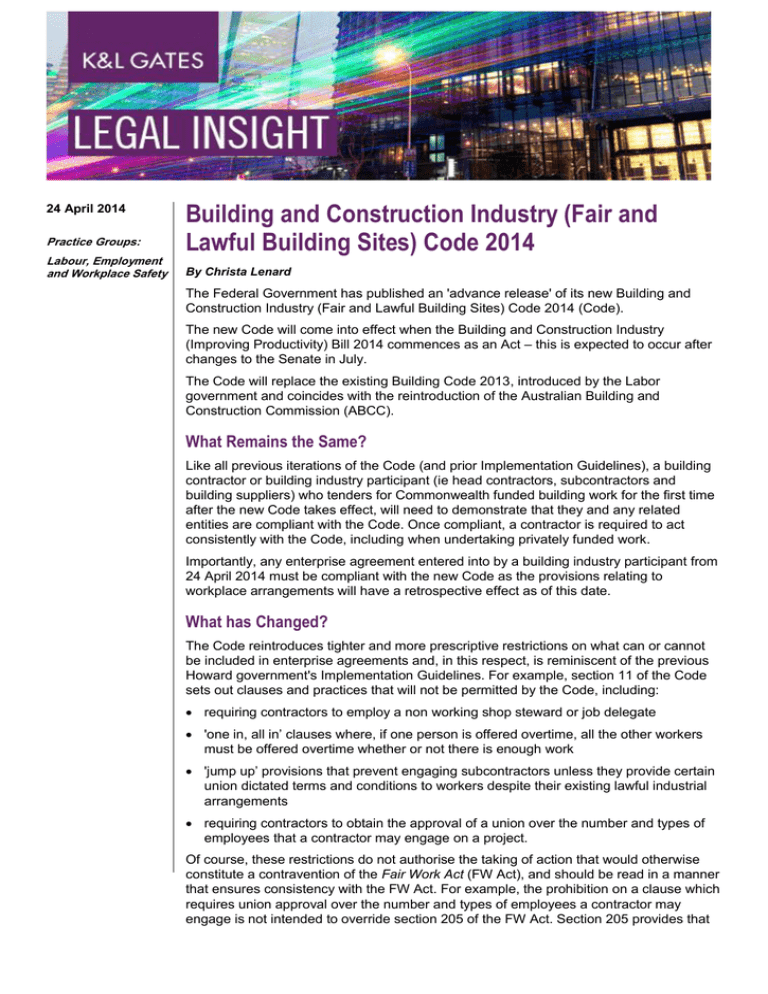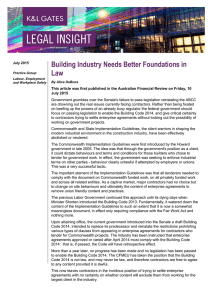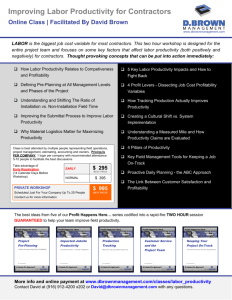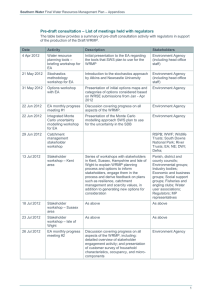
24 April 2014
Practice Groups:
Labour, Employment
and Workplace Safety
Building and Construction Industry (Fair and
Lawful Building Sites) Code 2014
By Christa Lenard
The Federal Government has published an 'advance release' of its new Building and
Construction Industry (Fair and Lawful Building Sites) Code 2014 (Code).
The new Code will come into effect when the Building and Construction Industry
(Improving Productivity) Bill 2014 commences as an Act – this is expected to occur after
changes to the Senate in July.
The Code will replace the existing Building Code 2013, introduced by the Labor
government and coincides with the reintroduction of the Australian Building and
Construction Commission (ABCC).
What Remains the Same?
Like all previous iterations of the Code (and prior Implementation Guidelines), a building
contractor or building industry participant (ie head contractors, subcontractors and
building suppliers) who tenders for Commonwealth funded building work for the first time
after the new Code takes effect, will need to demonstrate that they and any related
entities are compliant with the Code. Once compliant, a contractor is required to act
consistently with the Code, including when undertaking privately funded work.
Importantly, any enterprise agreement entered into by a building industry participant from
24 April 2014 must be compliant with the new Code as the provisions relating to
workplace arrangements will have a retrospective effect as of this date.
What has Changed?
The Code reintroduces tighter and more prescriptive restrictions on what can or cannot
be included in enterprise agreements and, in this respect, is reminiscent of the previous
Howard government's Implementation Guidelines. For example, section 11 of the Code
sets out clauses and practices that will not be permitted by the Code, including:
requiring contractors to employ a non working shop steward or job delegate
'one in, all in’ clauses where, if one person is offered overtime, all the other workers
must be offered overtime whether or not there is enough work
'jump up’ provisions that prevent engaging subcontractors unless they provide certain
union dictated terms and conditions to workers despite their existing lawful industrial
arrangements
requiring contractors to obtain the approval of a union over the number and types of
employees that a contractor may engage on a project.
Of course, these restrictions do not authorise the taking of action that would otherwise
constitute a contravention of the Fair Work Act (FW Act), and should be read in a manner
that ensures consistency with the FW Act. For example, the prohibition on a clause which
requires union approval over the number and types of employees a contractor may
engage is not intended to override section 205 of the FW Act. Section 205 provides that
Building and Construction Industry (Fair and Lawful Building Sites) Code
2014
an enterprise agreement must include a consultation term that provides for consultation
on major changes at the workplace.
The Code introduces the requirement for a Workplace Relations Management Plan
(WRMP) which is similar to the current Victorian and New South Wales State Guidelines.
A WRMP will be a condition of tender for any Commonwealth funded building work
where:
the value of the Commonwealth’s contribution to the project that includes the building
work is at least AUD5 million and represents at least 50% of the total construction
project value, or
the Commonwealth’s contribution to the project that includes the building work is at
least AUD10 million (irrespective of its proportion of the total construction project
value).
The ABCC will be responsible for approving any WRMP which is required to be
submitted by a prospective contractor and will only approve a proposed WRMP if it:
demonstrates how the Code covered entity will comply with the requirements of the
Code on the project to which the WRMP relates, and
sufficiently addresses the matters required to be addressed in Schedule 3 of the Code
(including information relating to workplace arrangements, productivity measures, risk
management, past performance and Code compliance) for the particular project.
The Code requires strict adherence to the Federal and relevant State right of entry and
safety laws, and inviting an officer of a building association to enter the site other than as
permitted under the FW Act will be considered a breach of Code.
Any threatened or actual industrial action will need to be reported to the ABCC as soon
as practicable and no later than 24 hours after first becoming aware of the threatened or
actual action. Similar notification requirements exist in respect of any potential breaches
of the Code.
If a Code covered entity is found to have breached the Code, the ABC Commissioner
may:
impose an exclusion sanction on the Code covered entity, or
issue a formal warning to the Code covered entity that a further failure may result in
the imposition of an exclusion sanction on the Code covered entity.
What Building Contractors and Industry Participants Need to do
Although we do not yet know the exact date as to when the Code will take effect, all
enterprise agreements made as of today will need to be compliant with the new Code. It
is therefore important that building contractors and building industry participants who are
in the process of, or will soon be negotiating enterprise agreements, ensure their
enterprise agreements meet the requirements of the Code..
More generally, building contractors and building industry participants should ready
themselves for the introduction of the new Code by ensuring that steps are taken to meet
the compliance requirements, including anticipating the submission of a comprehensive
and compliant WRMP for applicable Commonwealth funded projects they intend to
tender for.
Once engaged on a Code complaint project, building participants must consider
onsite behaviour, including ensuring they do not engage in conduct, or implement a
2
Building and Construction Industry (Fair and Lawful Building Sites) Code
2014
procedure or practice which is, or is likely to be prohibited under the Code, even if it
would be fine to do so under a pre-existing enterprise agreement.
Authors:
Christa Lenard
christa.lenard@klgates.com
+61.2.9513.2445
Anchorage Austin Beijing Berlin Boston Brisbane Brussels Charleston Charlotte Chicago Dallas Doha Dubai Fort Worth Frankfurt
Harrisburg Hong Kong Houston London Los Angeles Melbourne Miami Milan Moscow Newark New York Orange County Palo Alto
Paris Perth Pittsburgh Portland Raleigh Research Triangle Park San Diego San Francisco São Paulo Seattle Seoul Shanghai
Singapore Spokane Sydney Taipei Tokyo Warsaw Washington, D.C. Wilmington
K&L Gates practices out of 48 fully integrated offices located in the United States, Asia, Australia, Europe, the Middle East and
South America and represents leading global corporations, growth and middle-market companies, capital markets participants and
entrepreneurs in every major industry group as well as public sector entities, educational institutions, philanthropic organizations
and individuals. For more information about K&L Gates or its locations, practices and registrations, visit www.klgates.com.
This publication is for informational purposes and does not contain or convey legal advice. The information herein should not be used or relied upon
in regard to any particular facts or circumstances without first consulting a lawyer.
©2014 K&L Gates LLP. All Rights Reserved.
3





